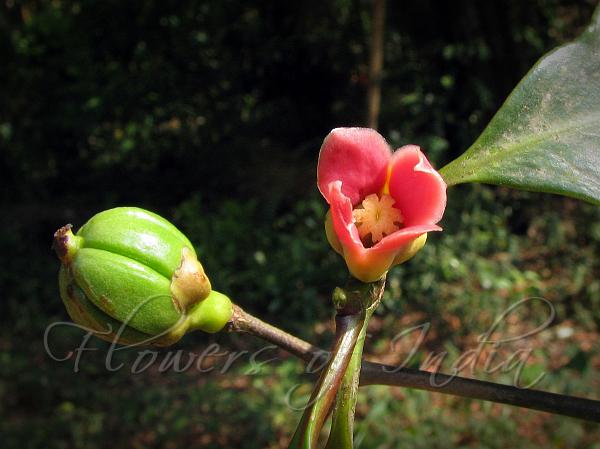|
| Cambodge Tree |
|

|

| File size | 481254 |
| Original date | 3/17/13 3:50 PM |
| Resolution | 2048 x 1536 |
| Flash | Flash did not fire, auto |
| Focal length | 6.0mm |
| Exposure time | 1/125s |
| Aperture | 7.1 |
| Focus Distance | |
| Metering Mode | Multi-segment |
| Camera make | Canon |
| Camera model | Canon PowerShot S5 IS |
| Sensor type | OneChipColorArea |
|
|
|
|
Photo: |
Botanical name: Garcinia gummi-gutta Family: Clusiaceae (Garcinia family)
Synonyms: Garcinia cambogia, Cambogia gemmi-gutta, Garcinia sulcata
Synonyms: Garcinia cambogia, Cambogia gemmi-gutta, Garcinia sulcata
Cambodge Tree is an evergreen, small or
medium-sized understorey tree, 5-20 m tall, about 70 cm bole diameter,
with a rounded crown and horizontal or drooping branches. The bark is
dark and smooth. Leaves are opposite, stalked, dark green, shining,
13-18 by 4-8 cm, elliptic to obovate, hairless. Leaf-stalks are 1.2-2.2
cm long. Flowers are borne in clusters of 4-20, are usually red, but
some trees have yellow ones. Petals are normally 4, each about 1.2 cm
wide 1.1 cm long, anthers attached to a pistillode with a
non-functional stigma. Female flowers occur singly or in clusters of up
to 4. The stigmatic surface is normally enlarged, and there is no
style. Female flowers have rudimentary and non-
functional staminodes. Neither male nor female flowers produce nectar.
Fruit is a green, ovoid berry, with 6-8 grooves, 5 cm in diameter,
yellow or red when ripe. Seed 6-8, smooth, large, about 5 cm long and 2
cm wide surrounded by a succulent aril. Cambodge Tree is found in
Western_Ghats and Sri Lanka.
Medicinal uses:  Plant pacifies vitiated vata, kapha, obesity, hypercholestremia,
diarrhea, colic, ulcers, inflammations and hyperperspiration. Useful
parts are leaves and dried fruits.
Plant pacifies vitiated vata, kapha, obesity, hypercholestremia,
diarrhea, colic, ulcers, inflammations and hyperperspiration. Useful
parts are leaves and dried fruits.
 Plant pacifies vitiated vata, kapha, obesity, hypercholestremia,
diarrhea, colic, ulcers, inflammations and hyperperspiration. Useful
parts are leaves and dried fruits.
Plant pacifies vitiated vata, kapha, obesity, hypercholestremia,
diarrhea, colic, ulcers, inflammations and hyperperspiration. Useful
parts are leaves and dried fruits. | Identification credit: Prashant Awale | Photographed at Mundgetaggal , North Karnataka. |
• Is this flower misidentified? If yes,